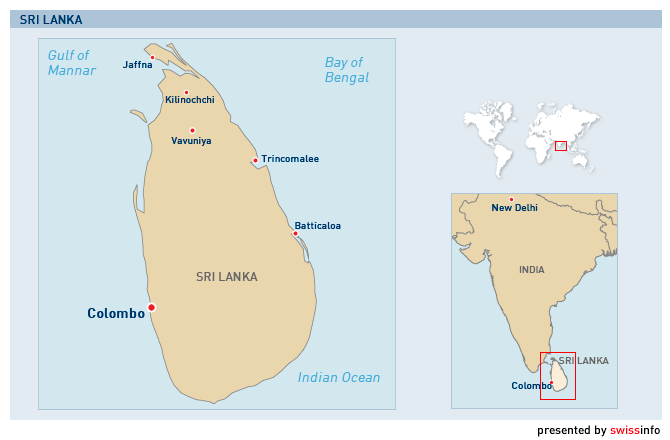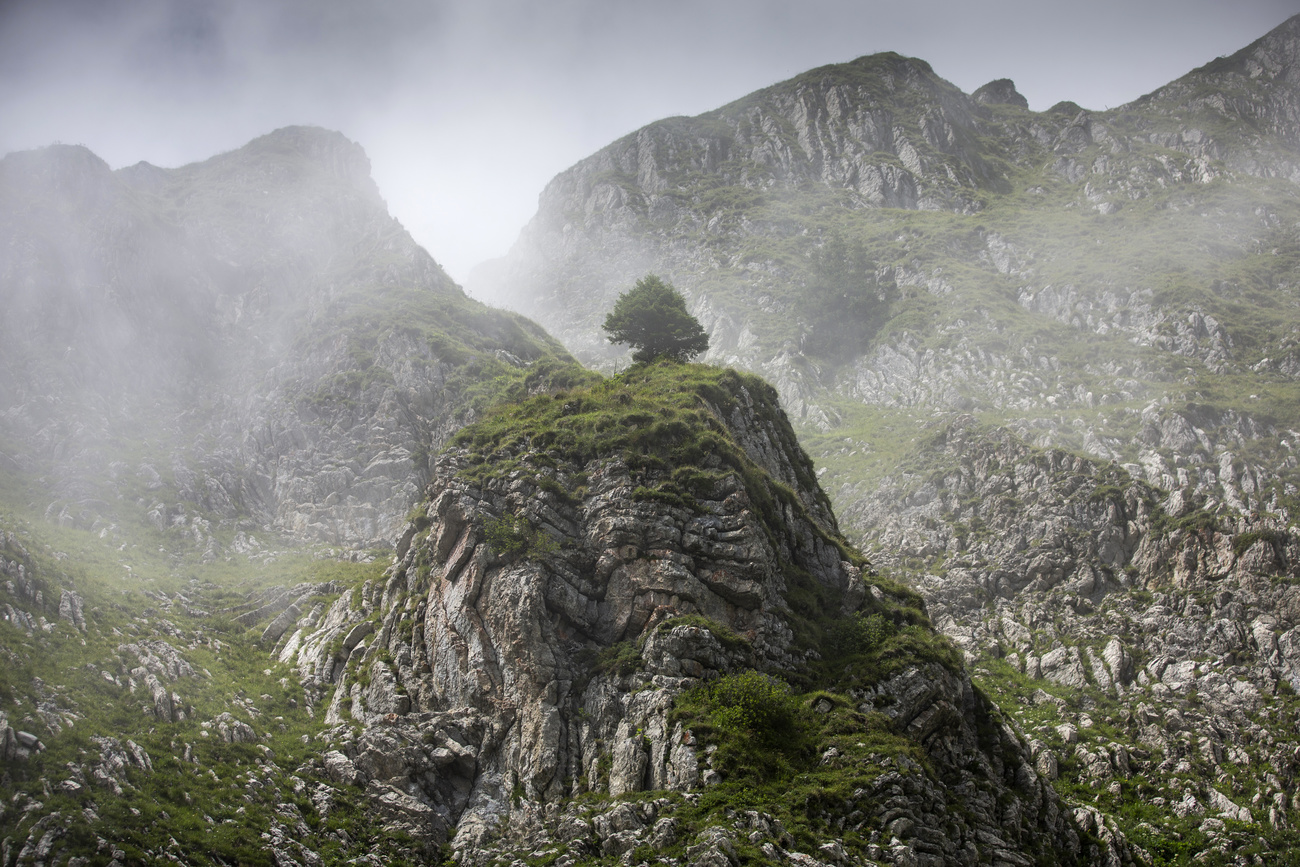Sri Lanka attacks provoke outcry

Reports that hundreds of Sri Lankan civilians in the northern war zone have been killed in recent artillery attacks have led to international protests.
Swiss experts have criticised the limited response to prevent the mounting civilian death toll, which the United Nations estimates at 6,500 people in three months.
A Sri Lankan government health official said a mortar shell struck the only functioning medical facility in Mullivaikal in northeast Sri Lanka on Tuesday morning, killing 49 patients and bystanders and wounding more than 50 others. It was the second time this month that the facility had come under heavy fire.
The attack came after reports of heavy shelling over the weekend that allegedly killed 430 ethnic Tamil civilians, including 106 children. But the death toll was likely to be closer to 1,000, said a health official.
The Sri Lankan military has denied using heavy weapons or aircraft against civilians in the area and has accused the rebel Liberation Tigers of Tamil Eelam (LTTE) of using mortars to fire on civilians for propaganda purposes.
The ministry of defence says its forces are currently advancing into the last remaining rebel stronghold. The UN estimates that 50,000 civilians remain trapped inside the tiny pocket of land in the northeast of the island.
Reports of the fighting are difficult to verify because the government bars journalists and aid workers from the war zone.
“Bloodbath”
UN Secretary-General Ban Ki-moon was said by his office to be appalled at the killings, which a UN spokesman earlier described as a “bloodbath”.
In a statement, Ban repeated his call for both parties to cease using heavy weapons. He also accused the rebels of “reckless disrespect” for the safety of civilians. Human rights groups have also accused the rebels of using civilians as human shields and shooting some who tried to flee.
The United States said on Monday it was deeply concerned about an “unacceptably high” level of civilian casualties and called on both the government and the LTTE to prevent civilian deaths.
“It’s a large-scale massacre,” Adrien-Claude Zoller, director of the non-governmental organisation (NGO) Geneva for Human Rights, told swissinfo.ch.
“The government is lying – no one doubts that. We’ve received photos of packed hospitals that have been bombed.
“The dream of those in power is to ethnically cleanse the zone and take away all the Tamils from the area. And the Tigers are fanatical, taking large parts of the population hostage.”
No safe areas
The Swiss-run International Committee of the Red Cross (ICRC), which has 20 national staff based in the rebel-held zone, said it had a ship waiting to deliver essential supplies and evacuate sick and wounded people.
But the situation on the ground was making it difficult to dock and carry out humanitarian operations. The last evacuation was on Saturday when 516 sick and wounded people were evacuated.
Since February 2009 the ICRC has evacuated 14,000 people from the war zone.
“But thousands remain trapped with fighting raging on,” ICRC spokesman Marçal Izard told swissinfo.ch.
“There are hardly any safe areas left. Getting water is a big challenge and even if we bring in food and medicines, it’s insufficient to meet basic needs.”
Security Council standoff
In New York the British, French and Austrian foreign ministers on Monday urged the UN Security Council to take action to prevent more killings of civilians.
Sri Lanka is not on the Security Council agenda because Russia, China, Japan and Vietnam consider the fighting an internal matter. It would require a vote to formally put Sri Lanka on the agenda of the Council, and Western diplomats say they have not yet got to the stage of pushing for that.
“Sri Lanka is a fairly low geo-strategic priority right now,” said Robert Muggah, research director of the Small Arms Survey at the Geneva Graduate Institute.
The LTTE has called for a truce and external intervention, but Sri Lanka has ruled out any truce, saying it would allow the Tigers another chance to rearm as it has in the past.
Political solution?
The UN chief urged Sri Lanka “to explore all possible options to bring the conflict to an end without further bloodshed” and asked the rebels to agree to a halt in the fighting.
It is critical to work on a political solution, said Adrien-Claude Zoller.
“The government can’t just eliminate all the Tamils and assimilate them into the Sinhalese majority,” he said. “Tamils represent some 20 per cent of the population and have a different language, writing and religion.”
But the voices of moderation have been silenced and donors, which have been “at their wits end” for a political solution, have been progressively marginalised, said Muggah.
The government has talked up its political plan, he added.
“But this is certainly secondary right now,” he said. “There is enormous support for this war in Colombo and throughout the south… above all the government wants to avenge its 30-year humiliation.”
Simon Bradley, swissinfo.ch
The Tigers started fighting in the 1970s for a separate state for Tamils in Sri Lanka’s north and east. They argued that successive majority Sinhalese governments had discriminated against the Tamils.
The conflict has killed an estimated 70,000 people, displaced thousands more and held back the island’s growth and economic development. The UN says 6,432 civilians were killed and 13,946 wounded in the three months from the end of January 2009.
The Tigers pulled out of talks in 2003 and again in 2006, claiming they were being sidelined, and between then and 2008 both sides accused each other of numerous breaches of the ceasefire as the country slid inexorably towards all out war.
Having announced the capture of Mullaitivu, the last of the Tamil Tigers’ northeastern strongholds, in February the Sri Lankan army said it was very close to defeating the rebels.
With a series of victories in recent months, the Sri Lankan military says it has boxed the insurgents into a small strip of northern coast, with water on both sides, measuring 2.5 square km. The UN estimates 50,000 civilians are trapped in the shrinking territory still under rebel control.
Both the military and the Tigers have been regularly accused of gross abuses of human rights by organisations such as Amnesty International and Human Rights Watch.
The military says around 200,000 civilians have fled the rebel-controlled zone this year. Those Tamils who left are in refugee camps, which aid agencies say have got better but still need millions of dollars to run. The LTTE says the facilities are “internment camps”, but the UN has said they are up to international standards. The only exception is people cannot leave, nor their relatives visit. The government says this is a temporary move to weed out Tiger infiltrators, and started resettling some families this month.
Sri Lankans are one of the biggest migrant groups in Switzerland.
There are 42,000 people of Sri Lankan origin in the country. Between 90 and 95 per cent of them are Tamils.
Since 1973 more than 11,000 Sri Lankans have acquired Swiss citizenship. One third of the Sri Lankans with permanent residence or Swiss citizenship were born in Switzerland.
The Tamils in Switzerland live mainly in the German-speaking areas, in particular cantons Bern, Zurich and Basel.


In compliance with the JTI standards
More: SWI swissinfo.ch certified by the Journalism Trust Initiative












You can find an overview of ongoing debates with our journalists here . Please join us!
If you want to start a conversation about a topic raised in this article or want to report factual errors, email us at english@swissinfo.ch.